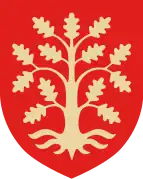Eide, Aust-Agder
Eide is a former municipality in the old Aust-Agder county in Norway. It is currently located within the municipality of Grimstad in Agder county. The municipality of Eide existed from 1838 until 1962. The 32.4-square-kilometre (12.5 sq mi) municipality included 29.2 square kilometres (11.3 sq mi) of land on the mainland and the rest being nearly 70 small islands off the Skaggerak coast. The larger islands include Auseøya, Homborøya, and Ålesøya.[1] The administrative centre was the village of Eide where the Eide Church is located. Other villages in Eide included Jortveit and Homborsund.
Eide herred | |
|---|---|
 View of Eide Church | |
 Aust-Agder within Norway | |
 Eide within Aust-Agder | |
| Coordinates: 58°16′11″N 08°28′41″E | |
| Country | Norway |
| County | Aust-Agder |
| District | Østre Agder |
| Established | 1 Jan 1838 |
| • Created as | Formannskapsdistrikt |
| Disestablished | 1 Jan 1964 |
| • Succeeded by | Landvik Municipality |
| Administrative centre | Eide |
| Area (upon dissolution)[1] | |
| • Total | 32.4 km2 (12.5 sq mi) |
| Population (1962) | |
| • Total | 504 |
| • Density | 16/km2 (40/sq mi) |
| Demonym | Eidesokning[2] |
| Time zone | UTC+01:00 (CET) |
| • Summer (DST) | UTC+02:00 (CEST) |
| ISO 3166 code | NO-0925 |
History

The municipality of Eide was created on 1 January 1838 (see formannskapsdistrikt law). During the 1960s, there were many municipal mergers across Norway due to the work of the Schei Committee. On 1 January 1962, the area of Gitmarkgårdene, with 22 inhabitants, was incorporated into the neighboring municipality of Lillesand. The rest of the municipality of Eide, with 504 inhabitants, was merged into the neighboring municipality of Landvik. Later, in 1971, Landvik was incorporated into the municipality of Grimstad.[3]
Name
The municipality (originally the parish) is named after the old Eide farm (Old Norse: Eiði) since the first Eide Church was built there. The name is the dative case of the word eið which means "isthmus". Tis is because the farm (and church) is located between two bodies of water: the Fosdalskilen and Engekilen.[1][4]
Government
While it existed, this municipality was responsible for primary education (through 10th grade), outpatient health services, senior citizen services, unemployment, social services, zoning, economic development, and municipal roads. During its existence, this municipality was governed by a municipal council of directly elected representatives. The mayor was indirectly elected by a vote of the municipal council.[5]
Municipal council
The municipal council (Herredsstyre) of Eide was made up of 13 representatives that were elected to four year terms. The tables below show the historical composition of the council by political party.
| Party Name (in Norwegian) | Number of representatives | |
|---|---|---|
| Labour Party (Arbeiderpartiet) | 2 | |
| Conservative Party (Høyre) | 4 | |
| Centre Party (Senterpartiet) | 7 | |
| Total number of members: | 13 | |
| Party Name (in Norwegian) | Number of representatives | |
|---|---|---|
| Labour Party (Arbeiderpartiet) | 2 | |
| Conservative Party (Høyre) | 4 | |
| Farmers' Party (Bondepartiet) | 6 | |
| Liberal Party (Venstre) | 1 | |
| Total number of members: | 13 | |
| Party Name (in Norwegian) | Number of representatives | |
|---|---|---|
| Labour Party (Arbeiderpartiet) | 2 | |
| Joint List(s) of Non-Socialist Parties (Borgerlige Felleslister) | 10 | |
| Total number of members: | 12 | |
| Party Name (in Norwegian) | Number of representatives | |
|---|---|---|
| Labour Party (Arbeiderpartiet) | 2 | |
| Joint List(s) of Non-Socialist Parties (Borgerlige Felleslister) | 10 | |
| Total number of members: | 12 | |
| Party Name (in Norwegian) | Number of representatives | |
|---|---|---|
| Labour Party (Arbeiderpartiet) | 2 | |
| Joint List(s) of Non-Socialist Parties (Borgerlige Felleslister) | 10 | |
| Total number of members: | 12 | |
| Party Name (in Norwegian) | Number of representatives | |
|---|---|---|
| Labour Party (Arbeiderpartiet) | 2 | |
| Joint List(s) of Non-Socialist Parties (Borgerlige Felleslister) | 10 | |
| Total number of members: | 12 | |
| Note: Due to the German occupation of Norway during World War II, no elections were held for new municipal councils until after the war ended in 1945. | ||
Notable people
- Reidar Haave Olsen (1923-1944), a pilot
References
- Kiær, Anders Nicolai; Helland, Amund; Vibe, Johan; Strøm, Boye (1904). Norges land og folk: Nedenes amt (in Norwegian). Norway: H. Aschehoug & Company. p. 368. Retrieved 6 November 2017.
- "Navn på steder og personer: Innbyggjarnamn" (in Norwegian). Språkrådet.
- Jukvam, Dag (1999). "Historisk oversikt over endringer i kommune- og fylkesinndelingen" (PDF) (in Norwegian). Statistisk sentralbyrå. ISBN 9788253746845.
- Rygh, Oluf (1905). Norske gaardnavne: Nedenes amt (in Norwegian) (8 ed.). Kristiania, Norge: W. C. Fabritius & sønners bogtrikkeri. p. 139.
- Hansen, Tore; Vabo, Signy Irene, eds. (20 September 2022). "kommunestyre". Store norske leksikon (in Norwegian). Kunnskapsforlaget. Retrieved 1 January 2023.
- "Kommunevalgene og Ordførervalgene 1959" (PDF) (in Norwegian). Oslo: Statistisk sentralbyrå. 1960. Retrieved 20 December 2020.
- "Kommunevalgene og Ordførervalgene 1955" (PDF) (in Norwegian). Oslo: Statistisk sentralbyrå. 1957. Retrieved 20 December 2020.
- "Kommunevalgene og Ordførervalgene 1951" (PDF) (in Norwegian). Oslo: Statistisk sentralbyrå. 1952. Retrieved 20 December 2020.
- "Kommunevalgene og Ordførervalgene 1947" (PDF) (in Norwegian). Oslo: Statistisk sentralbyrå. 1948. Retrieved 20 December 2020.
- "Kommunevalgene og Ordførervalgene 1945" (PDF) (in Norwegian). Oslo: Statistisk sentralbyrå. 1947. Retrieved 20 December 2020.
- "Kommunevalgene og Ordførervalgene 1937" (PDF) (in Norwegian). Oslo: Statistisk sentralbyrå. 1938. Retrieved 20 December 2020.
External links
 Aust-Agder travel guide from Wikivoyage
Aust-Agder travel guide from Wikivoyage The dictionary definition of Eide at Wiktionary
The dictionary definition of Eide at Wiktionary- Population data from Statistics Norway

